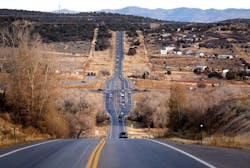U.S. faces $211B backlog in rural transportation improvements
The U.S. faces a $211 billion backlog in funding for needed repairs and improvements to the rural transportation system, according to a new report released this week by TRIP, a national transportation research nonprofit.
The report, Rural Connections: Challenges and Opportunities in America’s Heartland, evaluates the safety and condition of the nation’s rural roads and bridges and finds that the nation’s rural transportation system is in need of immediate improvements to address deficient roads and bridges, high crash rates, and inadequate connectivity and capacity.
TRIP says addressing the nation’s rural transportation challenges will require a significant increase in investment, but the tremendous decrease in vehicle travel that has occurred due to the COVID-19 pandemic is estimated to reduce state transportation revenues by at least 30%—approximately $50 billion—over the next 18 months.
The report finds that the nation’s rural roads and bridges have significant deficiencies. Thirteen percent of U.S. rural roads are rated in poor condition, while 21% are in mediocre condition. Sixteen percent of the nation’s rural roads are in fair condition and the remaining 50% are in good condition.
Eight percent of the nation’s rural bridges are rated in poor/structurally deficient condition, meaning there is significant deterioration to the major components of the bridge. Poor/structurally deficient bridges are often posted for lower weight or closed to traffic, restricting or redirecting large vehicles, including agricultural equipment, commercial trucks, school buses, and emergency services vehicles. Forty-seven percent of rural bridges are rated fair. A fair rating indicates that a bridge’s structural elements are sound but minor deterioration has occurred to the bridge’s deck, substructure or superstructure. The remaining 45% of rural bridges are rated in good condition.
The TRIP report finds that traffic crashes and fatalities on rural non-interstate roads are disproportionately high, occurring at a rate more than double that on all other roads. In 2018, non-interstate rural roads had a traffic fatality rate of two deaths for every 100 million vehicle miles of travel, compared to a fatality rate on all other roads of 0.88 deaths per 100 million vehicle miles of travel. TRIP says rural roads are more likely to have narrow lanes, limited shoulders, sharp curves, exposed hazards, pavement drop-offs, steep slopes, and limited clear zones along roadsides.
An analysis of the Status of the Nation’s Highways, Bridges and Transit, 23rd Edition, submitted by the U.S. DOT to Congress in 2019, indicates that the nation’s annual $28 billion investment by all levels of government in rural road, highway, and bridge rehabilitation and enhancements should be increased by 28%, to approximately $36 billion annually, to improve their condition, reliability, and safety.
-------
SOURCE: TRIP
